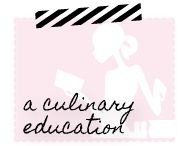The recipes taught in this course serve to develop skills by teaching the basics in order to inspire creativity. You'll learn the basic stocks (chicken, beef & fish) and how to make sauces out of those, how to roast a chicken, and many other things (more details below) essentially lots of 'quick wins' recipes to ensure that even the most inexperienced of chef feels good about the end product which works as encouragement to continue. There amount of food that you are sent home with from each class (that has a lab) could literally feed a person (with an average appetite) for at least 5 days.
My professor was lovely. I had a bit of cooking experience from years of helping my mother in the kitchen, but for those who were just starting out (i.e. those who were still burning toast) she was patient and nurturing. Not at all like Gordon Ramsey. More like Ina Garden.
Week 1: Stock 'er up!
This is a demonstration class only (meaning no practice lab). This class serves as an introduction to the Culinary Arts program at George Brown, discussing the uniform and tools needed to be successful. The professor demonstrated Fish, Chicken and Beef stocks and then turned those into sauces (Beef - Sauce Espagnole, Chicken - Chicken Veloute etc.) and introduced the sauce hierarchy (how to build on stocks to make variety of delectable sauces).
Week 2: Salad, salad and more salad
Vegetable cuts (Julienne, Julienne Allumette, Batonnet, Brunoise etc) are introduced in this class, as well as three salads, Cucumber Salad, Asian Beef Salad and Italian Pasta Salad - the latter is actually part of the first lab of the course. The Italian Pasta Salad was really tasty (and as I said before) there was enough of it to feed an army. I had it cold for a few days, but then because there is cheese and prosciutto in it, I threw it in the oven for a bit to make a hot pasta dish out of it. This turned out to be a successful experiment.
Week 3: Soup Kitchen
Minestrone and Chicken Noodle soup are covered in this class, with the Minestrone being part of the lab. The Chicken Noodle Soup that the instructor demonstrated was clear and comforting - like what you would expect of a restaurant.
Week 4: Lasagne C'est si bon!
In this class you'll learn how (and actually execute) to make a Sauce Bolognese with which you'll use to put together a lasagne.
The instructor was great at suggesting different ways to flavour a basic tomato sauce to achieve different flavours.
Also demonstrated in this class was a very rich (and so yummy) cheesy-garlic bread (because what is Lasagne without garlic bread?!?) and a basic tossed salad and vinaigrette. (Canada's food guide says you have eat your veggies!)
Week 5: Potatoes and a lil' bit of Fish.
An overview of potatoes starts this class off. Everything from Grade (who knew that potato could be graded?!?) to types of potato and what type of cooking is best for each kind. A demonstration of Duchesse, Marquis and Croquette potatoes (basically very fancy (think old school restaurant) ways to make potatoes)follows this introduction. The lab for this class has (funnily enough) nothing to do with potatoes. In the lab you'll be glazing carrots (believe it or not, there is a right and wrong way to glaze carrots...Who knew?!?) and making 'Sole Bonne Femme' (which - as it turns out - is a delightful fish recipe).
Week 6: The Incredible Edible Egg
The egg farmers of Canada would be proud. This week is devoted entirely to eggs. History, storage, grading and cookery of the egg start this class off. Followed by a demonstration Eggs Benedict, a Classic French Omlette and a Quiche Lorraine. The Quiche is part of the lab. I had never tried Quiche before and it turned out that I do like them, so this class was great. Pastry making is also covered in this class as you have to have something to put all that Quiche filling into before baking it.
Week 7: The Cooking Process
Now, this title does sound very vague, but it is exactly what it says...In this class you'll review the cooking process from roasting and pan frying to how to cook a green vegetable so that it stays a rich green appeasing colour that everyone including all the children at the table will want to eat -and doesn't turn into a puke-y green colour which the dog wouldn't even touch. The lab in this class is a Braised Steak in Red Wine and something called 'Vegetable Macedoine' (which is basically the fresh version of a frozen vegetable medley from Green Giant). The Braised Steak is good (go easy on the brown stock though). Chateau Potato (which is basically another fancy presentation on a basic potato) is also demonstrated in this class.
Week 8: The Classic Roasted Chicken
This is something every amateur chef should know how to do in my opinion (and since this is my blog, there will be a lot of my opinion included). It's a staple 'go-to' that even the most picky eaters will like, and when served with mashed potatoes, stuffing, maybe some mac & cheese and gravy serves as wonderful comfort food. This week's lab includes a classic roast chicken and Zucchini Provencal. (Bless George Brown for always doing their best at including some sort of vegetable dish). Onion and Sage Stuffing is also demonstrated in this class.
Week 9: Eastern Europe
One of the things I love most about taking cooking classes with George Brown is that it expands my horizons to new foods that, for the most part, I have never even heard of. I am pretty sure this is the class where I had my Oprah 'A-ha' moment and decided that I wanted to take more Culinary Arts courses. This week we ventured to Eastern European cuisine and covered off Pork Goulash, Beef Stroganoff and Spatzle. I had never heard of or tried Spatzle before, and something about the nutmeg-y flavour of this German pasta made my taste buds very happy. I have made this many times since being introduced to it (which has in turn has kept the dust off of my running shoes). Pork Goulash is also demonstrated in this class. Beef Stroganoff is part of the lab for this class. Let me start by saying that this is not like the hamburger helper stroganoff which I was used to. It's more like what one would get if ordering it in a restaurant. It was kind of tangy which added a new dimension to this stew and has (thankfully) forever turned me off of the boxed version.
Week 10: Coq au Vin & Rice Pilaf
In this class we covered off marinating chicken before cooking it (Coq au Vin). And Rice Pilaf (which was a good dish to show those who didn't know, how to make rice). Because of the time restraints of the class, the chicken couldn't be marinated overnight as what was recommended by the recipe, but it was still pretty good.
Week 11: Stuffing Things...
This week taught us how to safely stuff a pork chop, using the very sharp (and scary) boning knife (scary because my boning knife was so sharp that I barely had to look at it and somehow I would end up with a cut on my hands). The Pork Chops are stuffed with a prune stuffing, which wouldn't have been my first choice but when combined with apple sauce (which is also made in the lab part of this class) tasted pretty good. Spanish rice was only demonstrated in the class. This turned out to be a good basic rice dish that was a little more fancy then the rice pilaf and went well with many dishes. I have made this a few times since.
Week 12: Glazed Ham....
This was the final class and was a demo only class. Glazed Ham with cider sauce, scalloped potatoes and asparagus polonaise were demonstrated. After watching the glazed ham demo, I did try this at home and it turned out pretty good and was a lot easier then I thought it would be.
***
I learned a lot of techniques in this class which I have been able to apply to other courses offered in this program and also my every day cooking. I forgot to mention that each student gets to taste all the recipes after the demonstration portion of the class is completed - When i say 'taste', it actually turns into a small meal because of the sheer amount of food made during the demonstrations.
I hope my review has helped/inspired someone out there in the great big blogosphere.
I've taken a few of these courses so there are more reviews to come. Stay tuned!
Happy Cooking.



















There are a number of key ingredients that determine the culinary arts salary equation. A chef’s salary is customized and can only be predicted by considering unique circumstances.http://techniciansalary.net/culinary-arts-salary/
ReplyDeleteIt could be concluded that importance of Arts in our lives is very similar to entertainment. Now-a-days Art and Craft Education are encouraged at schools for children as it provides a platform for the young ones to express and explore their imagination.
ReplyDeleteArt
Step into Lava Lounge Houston, where culinary mastery meets welcoming hospitality. Located at 9705 Westheimer Rd, our restaurant has been delighting patrons with exquisite dishes and crafting memorable dining experiences for the past five years. lava lounge
ReplyDelete